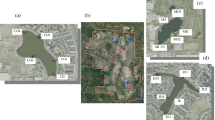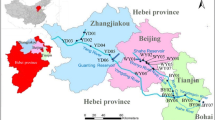Abstract
The indicator bacteria (standard plate count, total coliform, and fecal coliform bacteria) concentrations have been investigated using six ambient habitats (population density, percent sewer penetration, stream flow rate (m3/sec), percent residential area, percent forest area and percent agricultural area) in the Tama River basin in Tokyo, Japan during June 2003 to January 2005. The downstream and tributary Tama River showed higher concentrations of TC and FC bacteria than the upstream waters, which exceeded an environmental quality standard for rivers and a bathing water quality criterion. It was estimated that combined sewer overflow (CSO) and stormwater effluents contributed −4−23% to the indicator bacteria concentrations of the Tama River. The results of multiple regression analyses show that the indicator bacteria concentrations of Tama River basin are significantly affected by population density. It is concluded that the Tama River received a significant bacterial contamination load originating from the anthropogenic source.
Similar content being viewed by others
References
Ab Razak, I. A., & Christensen, E. R. (2001). Water quality before and after deep tunnel operation in Milwaukee, Wisconsin. Water Research, 35(11), 2683–2692.
Ahn, J.-H., Grant, S. B., Surbeck, C. Q., DiGiacomo, P. M., Nezlin, N. P., & Jiang, S. (2005). Coastal water quality impact of stormwater runoff from an urban watershed in Southern California. Environmental Science & Technology, 39(16), 5940–5953.
Ellis, J. B., & Yu, W. (1995). Bacteriology of urban runoff: the combined sewer as a bacterial reactor and generator. Water Science and Technology, 31(7), 303–310.
Fisher, D. S., Steiner, J. L., Endale, D. M., Stuedemann, J. A., Schomberg, H. H., Franzluebbers, A. J., et al. (2000). The relationship of land use practices to surface water quality in the Upper Oconee Watershed of Georgia. Forest Ecology and Management, 128, 39–48.
Garcia-Armisen, T., & Servais, P. (2007). Respective contributions of point and non-point sources of E. coli and enterococci in a large urbanized watershed (the Seine river, France). Journal of Environmental Management, 82, 512–518.
George, I., Anzil, A., & Servais, P. (2004). Quantification of fecal coliform inputs to aquatic systems through soil leaching. Water Research, 38, 611–618.
Hall, K. J., McCallum, D. W., Lee, K., & Macdonald, R. (1998). Characterization and aquatic impacts of combined sewer overflows in Greater Vancouver, British Columbia. Water Science and Technology, 38, 9–14.
Hiraishi, A., Saheki, K., & Horie, S. (1984). Relationship of total coliform, fecal coliform, and organic pollution levels in the Tamagawa River. Bulletin of the Japanese Society of Scientific Fisheries, 50(6), 991–997.
Japan Meteorological Agency. (2007a). Climatic Statistics in Japan, accessed at http://www.data.jma.go.jp/obd/stats/data/en/smp/47662_PRE_SM.html, 3/12/2007.
Japan Meteorological Agency. (2007b). Meteorological data in Japan, accessed at http://www.data.jma.go.jp/obd/stats/etrn, 3/12/2007 (in Japanese).
Japan Sewage Works Association (1997). Japanese standard testing methods for sewage. Tokyo, Japan: Japan Sewage Works Association, (in Japanese).
Japan Water Works Association (2001). Japanese standard testing methods for city water. Tokyo, Japan: Japan Water Works Association, (in Japanese).
Japanese Industrial Standards Committee (1998). Japanese industrial standard testing methods for industrial wastewater (JIS K 0102). Tokyo, Japan: Japanese Standard Associaton, (in Japanese).
Japanese Ministry of Construction (1998). Annual report of water quality, vol.37. Tokyo, Japan: Kanto-Kensetsu-Kosaikai, (in Japanese).
Katayama, H., Okuma, K., Furumai, H., & Ohgaki, S. (2004). Series of surveys for enteric viruses and indicator organisms in Tokyo Bay after an event of combined sewer overflow. Water Science and Technology, 50(1), 259–262.
Kawasaki City Government (2007a). Kawasaki’s innovative sewerage services for more vital and prosperous environment at the beginning of the 21st century. Kawasaki, Japan: Kawasaki City Government, (in Japanese).
Kawasaki City Government. (2007b). Statistics of Kawasaki City, accessed at http://www.city.kawasaki.jp/20/20tokei/home/toppage.htm, 3/16/2007 (in Japanese).
Kim, G.-H., Choi, E.-S., & Lee, D.-R. (2005). Diffuse and point pollution impacts on the pathogen indicator organism level in the Geum River, Korea. Science of the Total Environment, 350, 94–105.
Krapac, I. G., Dey, W. S., Roy, W. R., Smyth, C. A., Storment, E., Sargent, S. L., et al. (2002). Impacts of swine manure pits on groundwater quality. Environmental Pollution, 120, 475–492.
Kurosawa, R., Narusue, M., Kawachi, H., & Suzuki, K. (2000). Relation of jungle crows and garbage in Tokyo. Strix, 18, 71–78, (in Japanese with English summary).
Kurosawa, R., Narusue, M., Kawachi, H., & Suzuki, K. (2001). Relation of jungle crows and garbage in Tokyo II — Comparison between summer and winter season. Strix, 19, 71–79, (in Japanese with English summary).
Maillard, P., & Santos, N. A. P. (2008). A spatial-statistical approach for modeling the effect of non-point source pollution on different water quality parameters in the Velhas river watershed - Brazil. Journal of Environmental Management, 86, 158–70.
Maki, H., Sekiguchi, H., Hiwatari, T., Koshikawa, H., Kohata, K., Yamazaki, M., et al. (2007). Influences of storm water and combined sewage overflow on Tokyo Bay. Environmental Forensics, 8, 173–180.
Mallin, M. A., Williams, K. E., Esham, E. C., & Lowe, R. P. (2000). Effect of human development on bacteriological water quality in coastal watersheds. Ecological Applications, 10(4), 1047–1056.
Marsalek, J., & Rochfort, Q. (2004). Urban wet-weather flows: sources of fecal contamination impacting on recreation waters and threatening drinking-water sources. Journal of Toxicology and Environmental Health, Part A, 67, 1765–1777.
Ministry of Land, Infrastructure and Transport, Government of Japan (2007a). The Improvement of Combined Sewer System, accessed at http://www.mlit.go.jp/crd/city/sewerage/yakuwari/cso_kaizen.html, 3/16/2007 (in Japanese).
Ministry of Land, Infrastructure and Transport, Government of Japan (2007b). The Summary of Tama River basin, accessed at http://www.mlit.go.jp/river/gaiyou/seibi, 3/19/2007 (in Japanese).
Shah, V. G. R., Dunstan, H., Geary, P. M., Coombes, P., Roberts, T. K., & Rothkirch, T. (2007). Comparisons of water quality parameters from diverse catchments during dry periods and following rain events. Water Research, 41(16), 3655–666.
Tokyo Metropolitan Government (2004). Project summary of Tokyo Metropolitan Government Bureau of Sewerage. Tokyo, Japan: Tokyo Metropolitan Government Bureau of Sewerage, (in Japanese).
Tokyo Metropolitan Government (2005a). Project summary of Tokyo Metropolitan Government Bureau of Sewerage. Tokyo, Japan: Tokyo Metropolitan Government Bureau of Sewerage, (in Japanese).
Tokyo Metropolitan Government (2005b). Land of Tokyo in 2004. Tokyo, Japan: Bureau of Urban Development Tokyo Metropolitan Government, (in Japanese).
Tokyo Metropolitan Government (2006). Tokyo after 10 years — Tokyo changes. Tokyo: Headquarters of the Governor of Tokyo, (in Japanese).
Tokyo Metropolitan Government. (2007a). Statistics of Sewerage Systems in Tokyo, accessed at http://www.gesui.metro.tokyo.jp/english/no05.htm, 3/19/2007.
Tokyo Metropolitan Government. (2007b). Data base for water quality of public water body, accessed at http://www2.kankyo.metro.tokyo.jp/kansi/mizu/sokutei/sokuteikekka/kokyou.htm, 3/5/2007 (in Japanese).
Tokyo Metropolitan Government. (2007c). The Number of Identified Dogs in Tokyo and Japan, accessed at http://www.fukushihoken.metro.tokyo.jp/eisei/d_toukei/zenkoku-to.html, 3/5/2007 (in Japanese).
Tokyo Metropolitan Government. (2007d). Progressive Situation against Crow in Tokyo. In Current Topics (February 8, 2007), accessed at http://www.metro.tokyo.jp/INET/CHOUSA/2007/02/60h28100.htm, 3/5/2007 (in Japanese).
Tong, S. T. Y., & Chen, W. (2002). Modeling the relationship between land use and surface water quality. Journal of Environmental Management, 66, 377–393.
Turnbull, D. A., & Bevan, J. R. (1995). The impact of airport de-icing on a river: the case of the Ouseburn, Newcastle-upon-Tyne. Environmental Pollution, 88, 321–332.
Young, K. D., & Thackston, E. L. (1999). Housing density and bacterial loading in urban streams. Journal of Environmental Engineering, 125, 1177–1180.
Wild Bird Society of Japan (2001). The manual for local government officials who deal directly with complaints from citizens against crows. Tokyo, Japan: Nature Conservation Bureau, Ministry of the Environment Government of Japan, (in Japanese).
Zhu, K., Zhang, L., Hart, W., Liu, M., & Chen, H. (2004). Quality issues in harvested rainwater in arid and semi-arid Loess Plateau of northern China. Journal of Arid Environments, 57, 487–505.
Author information
Authors and Affiliations
Corresponding author
Rights and permissions
About this article
Cite this article
Ham, YS., Kobori, H. & Takasago, M. Effects of combined sewer overflow and stormwater on indicator bacteria concentrations in the Tama River due to the high population density of Tokyo Metropolitan area. Environ Monit Assess 152, 459–468 (2009). https://doi.org/10.1007/s10661-008-0330-6
Received:
Accepted:
Published:
Issue Date:
DOI: https://doi.org/10.1007/s10661-008-0330-6




